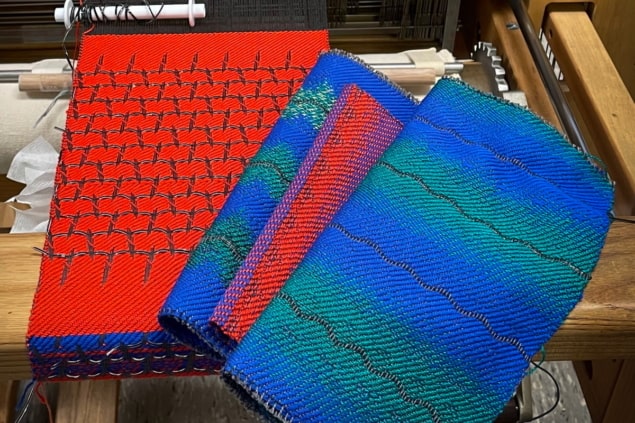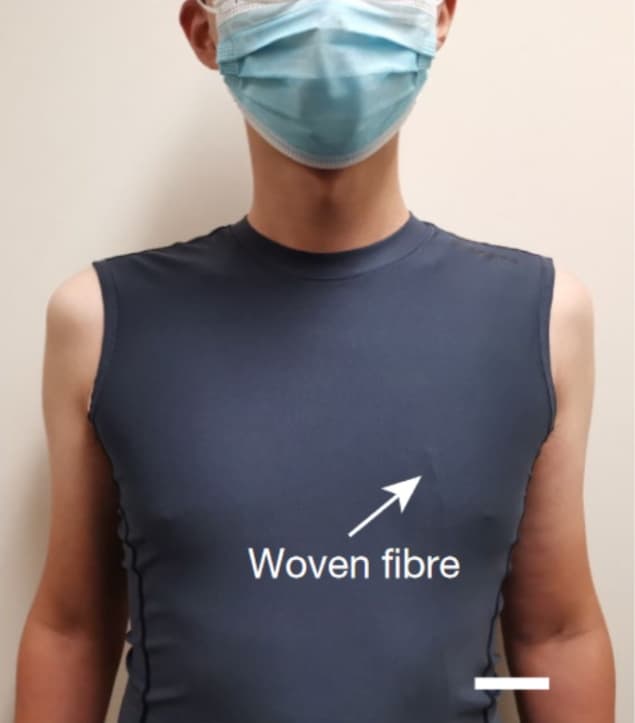Acoustic clothing can hear your heart beat
05 Apr 2022

A piezoelectric fibre that enables fabrics to detect sound has been developed by a research team in the US. According to the team, a single strand of this fibre can turn tens of square metres of fabric into a microphone that senses mechanical vibrations created by sound and converts them into an electrical signal. Reporting their findings in Nature, the researchers demonstrate that when used to create clothes, such fabrics could enable a range of medical and communications applications.
As pretty much everyone wears fabrics close to their skin every day, materials scientist Wei Yan, who was based at Massachusetts Institute of Technology but recently moved to Nanyang Technological University in Singapore, and his colleagues wondered whether fabrics could be used to detect and process sound.
The idea was to use a fabric that can translate the pressure waves of sound travelling through air into mechanical vibrations. The researchers would then weave into this fabric a piezoelectric fibre that could convert this vibration into an electrical signal. They were inspired by the human eardrum, which is a membrane constructed of a circular arrangement of fibres. It converts sound waves into mechanical vibrations that are transmitted to the cochlea, which converts them to electrical signals that are picked up by the nervous system.
To create a suitable piezoelectric fibre, the researchers loaded a piezoelectric polymer with piezoelectric barium titanate nanoparticles. This composite was then heated and drawn into a thin, 40-metre-long fibre. They then applied a cycle of electrical charges to the fibre to create aligned electric dipoles in the material.
These processes created a material with excellent piezoelectric properties. Microscopic analysis showed that during the drawing process, voids formed around the barium titanate nanoparticles. According to the researchers, this cavitation appears to improve the piezoelectric performance. They found that the fibre had considerably higher piezoelectric charge coefficient than a drawn fibre of the same polymer without the nanoparticles, or a hot-pressed polymer and barium titanate composite. It also exhibited superior performance to other similar piezoelectric materials.
 Fabric stethoscope An acoustic shirt in contact with a person’s chest can efficiently capture cardiac signals. (Courtesy: Nature 10.1038/s41586-022-04476-9)
Fabric stethoscope An acoustic shirt in contact with a person’s chest can efficiently capture cardiac signals. (Courtesy: Nature 10.1038/s41586-022-04476-9)On its own, the piezoelectric fibre responded to acoustic waves in the audible range. But when the researchers mounted the fibre on a membrane of Mylar – a polyester film – the electrical output was two orders of magnitude higher, due to strong coupling between the fibre and the mechanical vibrations in the membrane. In tests using recorded sounds with volumes ranging from that of a quiet library to heavy traffic, the output voltage increased linearly with sound levels.
Next, the researchers created a shirt out of a fabric made from cotton and a stiffer fibre called Twaron, and incorporated a single piezoelectric fibre in the chest area. They found that this garment could accurately hear and measure the wearer’s heartbeat and was able to detect different heart sounds. As well as measuring cardiac function, the researchers say that such fabrics could potentially monitor breathing and could be incorporated into maternity wear to monitor a baby’s foetal heartbeat.
“This fabric can imperceptibly interface with the human skin, enabling wearers to monitor their heart and respiratory condition in a comfortable, continuous, real-time and long-term manner,” says Yan.
 Direction detection A shirt containing two fibres is used to detect the direction of a sound. (Courtesy: Nature 10.1038/s41586-022-04476-9)
Direction detection A shirt containing two fibres is used to detect the direction of a sound. (Courtesy: Nature 10.1038/s41586-022-04476-9)The fabrics can also produce sounds, like a speaker, when an electric signal is applied to the piezoelectric fibre. The researchers even demonstrated that two shirts could communicate with each other by each receiving sounds and emitting recordings of spoken words. They also created a shirt containing two piezoelectric fibres that could detect the direction of a hand clap.
According to the team, such functions could have a number of uses, including helping those with hearing problems communicate. “Wearing an acoustic garment, you might talk through it to answer phone calls and communicate with others,” Yan explains.
In an accompanying News and Views article in Nature, Wenhui Song, a materials and medical engineer at University College London, writes that this work pushes “audible sensing to a new high”, adding that the piezoelectric device “takes us a step closer to a future in which wearable electronics are integrated into our everyday lives”. She cautions, however, that there are still issues to overcome, such as real-world background noise and incorporating all the other electronics needed to create a wearable device.
Michael Allen is a science writer based in the UK.
from physicswoerld.com 7/4/2022
Δεν υπάρχουν σχόλια:
Δημοσίευση σχολίου